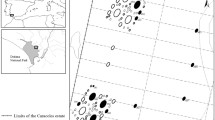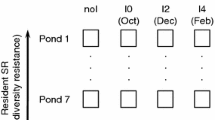Abstract
We conducted an outdoor container experiment to test the hypothesis that the genetic composition of resident populations influences the establishment success of immigrant species. We manipulated the genetic compositions (source populations) of populations of the water flea Daphnia magna, a strong competitor in pond and shallow lake zooplankton communities, and monitored the establishment success of immigrant cladoceran species of a regional species pool. We show that establishment success is affected by the source population of the resident D. magna as well as by the presence/absence of macrophytes and the presence/absence of fish in the containers. Our results provide evidence that the genetic composition of resident populations can impact community assembly and metacommunity dynamics, and that community genetics can influence ecosystem functioning.




Similar content being viewed by others
References
Agrawal AA (2003) Community genetics: new insights into community ecology by integrating population genetics. Ecology 84:543–544
Burks RL, Jeppesen E, Lodge DM (2001) Littoral zone structures as Daphnia refugia against fish predators. Limnol Oceanogr 46:230–237
Chase JM, Leibold MA (2002) Spatial scale dictates the productivity-biodiversity relationship. Nature 416:427–430
Cottenie K, De Meester L (2004) Metacommunity structure: Synergy of biotic interactions as selective agents and dispersal as fuel. Ecology 85:114–119
Cousyn C, De Meester L, Colbourne JK, Brendonck L, Verschuren D, Volckaert F (2001) Rapid, local adaptation of zooplankton behavior to changes in predation pressure in the absence of neutral genetic changes. Proc Natl Acad Sci USA 98:6256–6260
Davis MB, Shaw RG, Etterson JR (2005) Evolutionary responses to changing climate. Ecology 86:1704–1714
De Meester L, Gómez A, Okamura B, Schwenk K (2002) The monopolization hypothesis and the dispersal-gene flow paradox in aquatic organisms. Acta Oecologica 23:121–135
Grant PR, Grant BR (2002) Unpredictable evolution in a 30-year study of Darwin’s finches. Science 296:707–711
Hairston NG, Ellner SP, Geber MA, Yoshida T, Fox JA (2005) Rapid evolution and the convergence of ecological and evolutionary time. Ecol Lett 8:1114–1127
Hanski I (1998) Metapopulation dynamics. Nature 396:41–49
Hendry AP, Kinnison MT (1999) The pace of modern life: measuring rates of contemporary microevolution. Evolution 53:1637–1653
Holyoak M, Leibold MA, Holt RD (eds) (2005) Metacommunities: spatial dynamics and ecological communities. University of Chicago Press, Chicago, IL
Lambrinos JG (2004) How interactions between ecology and evolution influence contemporary invasion dynamics. Ecology 85:2061–2070
Lauridsen TL, Lodge DM (1996) Avoidance by Daphnia magna of fish and macrophytes: Chemical cues and predator-mediated use of macrophyte habitat. Limnol Oceanogr 41:794–798
Leibold MA, Holyoak M, Mouquet N, Amarasekare P, Chase JM, Hoopes MF, Holt RD, Shurin JB, Law R, Tilman D, Loreau M, Gonzalez A (2004) The metacommunity concept: A framework for multi-scale community ecology. Ecol Lett 7:601–613
Levine JM (2000) Species diversity and biological invasions: relating local process to community pattern. Science 288:852–854
McCauley E (1984) The estimation of the abundance and biomass of zooplankton in samples. In: Downing JA, Rigler FH (eds) A manual on methods for the assessment of secondary productivity in fresh waters. Blackwell, Oxford, pp 228–265
Olsen EM, Heino M, Lilly GR, Morgan MJ, Brattey J, Ernande B, Dieckmann U (2004) Maturation trends indicative of rapid evolution preceded the collapse of northern cod. Nature 428:932–935
Pauwels K, Stoks R, De Meester L (2005) Coping with predator stress: interclonal differences in induction of heat-shock proteins in the water flea Daphnia magna. J Evol Biol 18:867–872
Scheffer M (1998) Ecology of shallow lakes. Chapman and Hall, London
Schlaepfer MA, Runge MC, Sherman PW (2002) Ecological and evolutionary traps. Trends Ecol Evol 17:474–480
Schlaepfer MA, Sherman PW, Blossey B, Runge MC (2005) Introduced species as evolutionary traps. Ecol Lett 8:241–246
StatSoft Inc. (2004) Electronic statistics textbook. StatSoft Inc., Tulsa, OK
Stockwell CA, Hendry AP, Kinnison MT (2003) Contemporary evolution meets conservation biology. Trends Ecol Evol 18:94–101
Talling JF, Driver D (1963) Some problems in the estimation of chlorophyll a in phytoplankton. In: Doty MS(ed) Proceedings of the conference on primary production measurements, marine and freshwaters (TID-7633). US Atomic Energy Commission, Oak Ridge, TN, pp 142–146
Urban MC, Skelly DK (2006) Evolving metacommunities: toward an evolutionary perspective on metacommunities. Ecology 87:1616–1626
Vellend M (2005) Species diversity and genetic diversity: parallel processes and correlated patterns. Am Nat 166:199–215
Vellend M, Geber MA (2005) Connections between species diversity and genetic diversity. Ecol Lett 8:767–781
Yoshida T, Jones LE, Ellner SP, Fussmann GF, Hairston NG (2003) Rapid evolution drives ecological dynamics in a predator-prey system. Nature 424:303–306
Yoshida T, Hairston NG, Ellner SP (2004) Evolutionary trade-off between defence against grazing and competitive ability in a simple unicellular alga, Chlorella vulgaris. Proc R Soc Biol 271:1947–1953
Weltzin J F, Muth NZ, Von Holle B, Cole PG (2003) Genetic diversity and invasibility: a test using a model system with a novel experimental design. Oikos 103:505–518
Whitham TG, Young WP, Martinsen GD, Gehring CA, Schweitzer JA, Shuster SM, Wimp GM, Fischer DG, Bailey JK, Lindroth LR, Woolbright S, Kuske GR (2003) Community and ecosystem genetics: a consequence of the extended phenotype. Ecology 84:559–573
Williamson M (1999) Invasions. Ecography 22:5–12
Acknowledgments
This study was financially supported by the K. U. Leuven Research Fund (project OT/04/23) and by the ESF EURODIVERSITY program (project BIOPOOL, nationally funded by Belspo and Fund for Scientific Research, Flanders). We thank R. Brandl and two anonymous reviewers for constructive comments on earlier versions of the manuscript.
Author information
Authors and Affiliations
Corresponding author
Additional information
Communicated by Roland Brandl.
Rights and permissions
About this article
Cite this article
De Meester, L., Louette, G., Duvivier, C. et al. Genetic composition of resident populations influences establishment success of immigrant species. Oecologia 153, 431–440 (2007). https://doi.org/10.1007/s00442-007-0721-3
Received:
Accepted:
Published:
Issue Date:
DOI: https://doi.org/10.1007/s00442-007-0721-3




